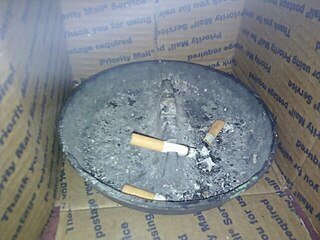Related Research Articles

A carcinogen is any substance, radionuclide, or radiation that promotes carcinogenesis, the formation of cancer. This may be due to the ability to damage the genome or to the disruption of cellular metabolic processes. Several radioactive substances are considered carcinogens, but their carcinogenic activity is attributed to the radiation, for example gamma rays and alpha particles, which they emit. Common examples of non-radioactive carcinogens are inhaled asbestos, certain dioxins, and tobacco smoke. Although the public generally associates carcinogenicity with synthetic chemicals, it is equally likely to arise in both natural and synthetic substances. Carcinogens are not necessarily immediately toxic; thus, their effect can be insidious.

A cigarette is a narrow cylinder containing burnable material, typically tobacco, that is rolled into thin paper for smoking. The cigarette is ignited at one end, causing it to smolder; the resulting smoke is orally inhaled via the opposite end. Cigarette smoking is the most common method of tobacco consumption. Manufacturers have described the cigarette as "a drug administration system for the delivery of nicotine in acceptable and attractive form." The term cigarette, as commonly used, refers to a tobacco cigarette, but the word is sometimes used to refer to other substances, such as a cannabis (Jazz) cigarette or an herbal cigarette. A cigarette is distinguished from a cigar by its usually smaller size, use of processed leaf, and paper wrapping, which is typically white. A cigarette may be called a fag in British slang. Many other terms are used for cigarettes, including cigs, ciggies, smokes, darts, stogs, boges, and tabs.

The tobacco industry comprises those persons and companies who are engaged in the growth, preparation for sale, shipment, advertisement, and distribution of tobacco and tobacco-related products. It is a global industry; tobacco can grow in any warm, moist environment, which means it can be farmed on all continents except Antarctica.

Tobacco smoking is the practice of burning tobacco and ingesting the smoke that is produced. The smoke may be inhaled, as is done with cigarettes, or simply released from the mouth, as is generally done with pipes and cigars. The practice is believed to have begun as early as 5000–3000 BC in Mesoamerica and South America. Tobacco was introduced to Eurasia in the late 17th century by European colonists, where it followed common trade routes. The practice encountered criticism from its first import into the Western world onwards but embedded itself in certain strata of a number of societies before becoming widespread upon the introduction of automated cigarette-rolling apparatus.

Passive smoking is the inhalation of tobacco smoke, called secondhand smoke (SHS), or environmental tobacco smoke (ETS), by persons other than the intended "active" smoker. It occurs when tobacco smoke enters an environment, causing its inhalation by people within that environment. Exposure to secondhand tobacco smoke causes disease, disability, and death. The health risks of secondhand smoke are a matter of scientific consensus. These risks have been a major motivation for smoke-free laws in workplaces and indoor public places, including restaurants, bars and night clubs, as well as some open public spaces.

Cotinine is an alkaloid found in tobacco and is also the predominant metabolite of nicotine. An anagram of the word "nicotine", it is used as a biomarker for exposure to tobacco smoke. Cotinine is currently being studied as a treatment for depression, PTSD, schizophrenia, Alzheimer's disease and Parkinson's disease. Cotinine was developed as an antidepressant as a fumaric acid salt, cotinine fumarate, to be sold under the brand name Scotine but it was never marketed.
Tar is the name for the resinous, partially combusted particulate matter made by the burning of tobacco and other plant material in the act of smoking. Tar is toxic and damages the smoker's lungs over time through various biochemical and mechanical processes. Tar also damages the mouth by rotting and blackening teeth, damaging gums, and desensitizing taste buds. Tar includes the majority of mutagenic and carcinogenic agents in tobacco smoke. Polycyclic aromatic hydrocarbons (PAH), for example, are genotoxic via epoxidation.

N-Nitrosonornicotine (NNN) is a tobacco-specific nitrosamine produced during the curing and processing of tobacco. It has been classified as a Group 1 carcinogen. Although no adequate studies of the relationship between exposure to NNN and human cancer have been reported, there is sufficient evidence that NNN causes cancer in experimental animals.

Tobacco use has predominantly negative effects on human health and concern about health effects of tobacco has a long history. Research has focused primarily on cigarette smoking.

Cannabis smoking is the inhalation of smoke or vapors released by heating the flowers, leaves, or extracts of cannabis and releasing the main psychoactive chemical, Δ9-tetrahydrocannabinol (THC), which is absorbed into the bloodstream via the lungs. Archaeological evidence indicates cannabis with high levels of THC was being smoked at least 2,500 years ago.

Herbal cigarettes are cigarettes that usually do not contain any tobacco or nicotine, instead being composed of a mixture of various herbs and/or other plant material. However, Chinese herbal cigarettes contain tobacco and nicotine with herbs added, unlike European and North American herbal cigarettes which have tobacco and nicotine omitted. Like herbal smokeless tobacco, they are often used as a substitute for standard tobacco products. Herbal cigarettes are often advertised as a smoking cessation aid. They are also used in acting scenes by performers who are non-smokers, or—as is becoming increasingly common—where anti-smoking legislation prohibits the use of tobacco in public spaces. Herbal cigarettes can carry carcinogens which can have health implications.

Sidestream smoke is smoke which goes into the air directly from a burning cigarette, cigar, or smoking pipe. Sidestream smoke is the main component of second-hand smoke (SHS), also known as Environmental Tobacco Smoke (ETS) or passive smoking. The relative quantity of chemical constituents of sidestream smoke are different from those of directly inhaled ("mainstream") smoke, although their chemical composition is similar. Sidestream smoke has been classified as a Class A carcinogen by the U.S. Environmental Protection Agency.

A hookah lounge is an establishment where patrons share shisha from a communal hookah or from one placed at each table or a bar.
Tobacco harm reduction (THR) is a public health strategy to lower the health risks to individuals and wider society associated with using tobacco products. It is an example of the concept of harm reduction, a strategy for dealing with the use of drugs. Tobacco smoking is widely acknowledged as a leading cause of illness and death, and reducing smoking is vital to public health.
Third-hand smoke is contamination by tobacco smoke that lingers following the extinguishing of a cigarette, cigar, or other combustible tobacco product. First-hand smoke refers to what is inhaled into the smoker's own lungs, while second-hand smoke is a mixture of exhaled smoke and other substances leaving the smoldering end of the cigarette that enters the atmosphere and can be inhaled by others. Third-hand smoke or "THS" is a neologism coined by a research team from the Dana–Farber/Harvard Cancer Center, where "third-hand" is a reference to the smoking residue on surfaces after "second-hand smoke" has cleared out.

Smoking is a practice in which a substance is burned and the resulting smoke is typically breathed in to be tasted and absorbed into the bloodstream. Most commonly, the substance used is the dried leaves of the tobacco plant, which have been rolled into a small rectangle of rolling paper to create a small, round cylinder called a cigarette. Smoking is primarily practised as a route of administration for recreational drug use because the combustion of the dried plant leaves vaporizes and delivers active substances into the lungs where they are rapidly absorbed into the bloodstream and reach bodily tissue. In the case of cigarette smoking these substances are contained in a mixture of aerosol particles and gases and include the pharmacologically active alkaloid nicotine; the vaporization creates heated aerosol and gas into a form that allows inhalation and deep penetration into the lungs where absorption into the bloodstream of the active substances occurs. In some cultures, smoking is also carried out as a part of various rituals, where participants use it to help induce trance-like states that, they believe, can lead them to spiritual enlightenment.

Ventilated cigarettes are considered to have a milder flavor than regular cigarettes. These cigarette brands may be listed as having lower levels of tar ("low-tar"), nicotine, or other chemicals as "inhaled" by a "smoking machine". However, the scientific evidence is that switching from regular to light or low-tar cigarettes does not reduce the health risks of smoking or lower the smoker's exposure to the nicotine, tar, and carcinogens present in cigarette smoke.
The Tobacco Institute, Inc. was a United States tobacco industry trade group, founded in 1958 by the American tobacco industry. It was dissolved in 1998 as part of the Tobacco Master Settlement Agreement.

Muʽassel, or maassel, is a syrupy tobacco mix containing molasses, vegetable glycerol and various flavourings which is smoked in a hookah, a type of waterpipe. It is also known as "shisha".
Animals are exposed to tobacco smoke and other cigarette by-products through their use as experimental subjects and through contact with smokers, as in the case of pets in houses where smoking takes place.
References
- ↑ Talhout, Reinskje; Schulz, Thomas; Florek, Ewa; Van Benthem, Jan; Wester, Piet; Opperhuizen, Antoon (2011). "Hazardous Compounds in Tobacco Smoke". International Journal of Environmental Research and Public Health. 8 (12): 613–628. doi: 10.3390/ijerph8020613 . ISSN 1660-4601. PMC 3084482 . PMID 21556207.
- ↑ "About the Report on Carcinogens". Archived from the original on 2013-04-10. Retrieved 2013-04-16.
- ↑ Godwin, W. S.; Subha, V. R.; Feroz, K. M. (2010). "210Po radiation dose due to cigarette smoking" (PDF). Current Science. 98: 681–686. Retrieved 26 July 2014.
